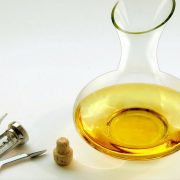A Guide to Drinking Old Wine – Part 2 – Storing and Opening
Older reds and a few whites will have sediment, made up of yeast, tannin, and tartrates. It tastes gritty and unpleasant and must be removed. Sediment will mix into the wine with any touch, so it is best to lay the bottle on its side for a couple weeks. The sediment will sink to the lower side of the bottle. Standing the bottle up about 24 hours before drinking will move that sediment into the bottom corner and enable you to stand the bottle up when opening. Take care to handle the bottle carefully, and not make any sudden movements. A good practice is to store the bottle with the label facing up; that way you will always know where the sediment is.
Remember to keep the label facing up while you pour.
Opening an older wine can be a bit of a challenge. Remove the foil completely. Sometimes it sticks to the cork and neck of the bottle if some wine has seeped out. The cork may be near disintegration, and a typical corkscrew will chew a hole into the center without dislodging, causing bits of cork to fall into the wine. The Coravin will blast air into the bottle and shake everything up. The “rabbit-eared” ah-so is the best tool for removing the aged cork. It grips the cork from the outside and by using a diagonal twisting motion; you can remove the intact cork. There are also new openers on the market which are made specifically for older bottles, incorporating both an ah-so and corkscrew into the same tool. Old cork often breaks, but be careful not to drop any cork fragments into the bottle. If this does happen, the fragments can be strained later.
Always keep the bottle upright and try to minimize shaking, otherwise sediment will become suspended.








